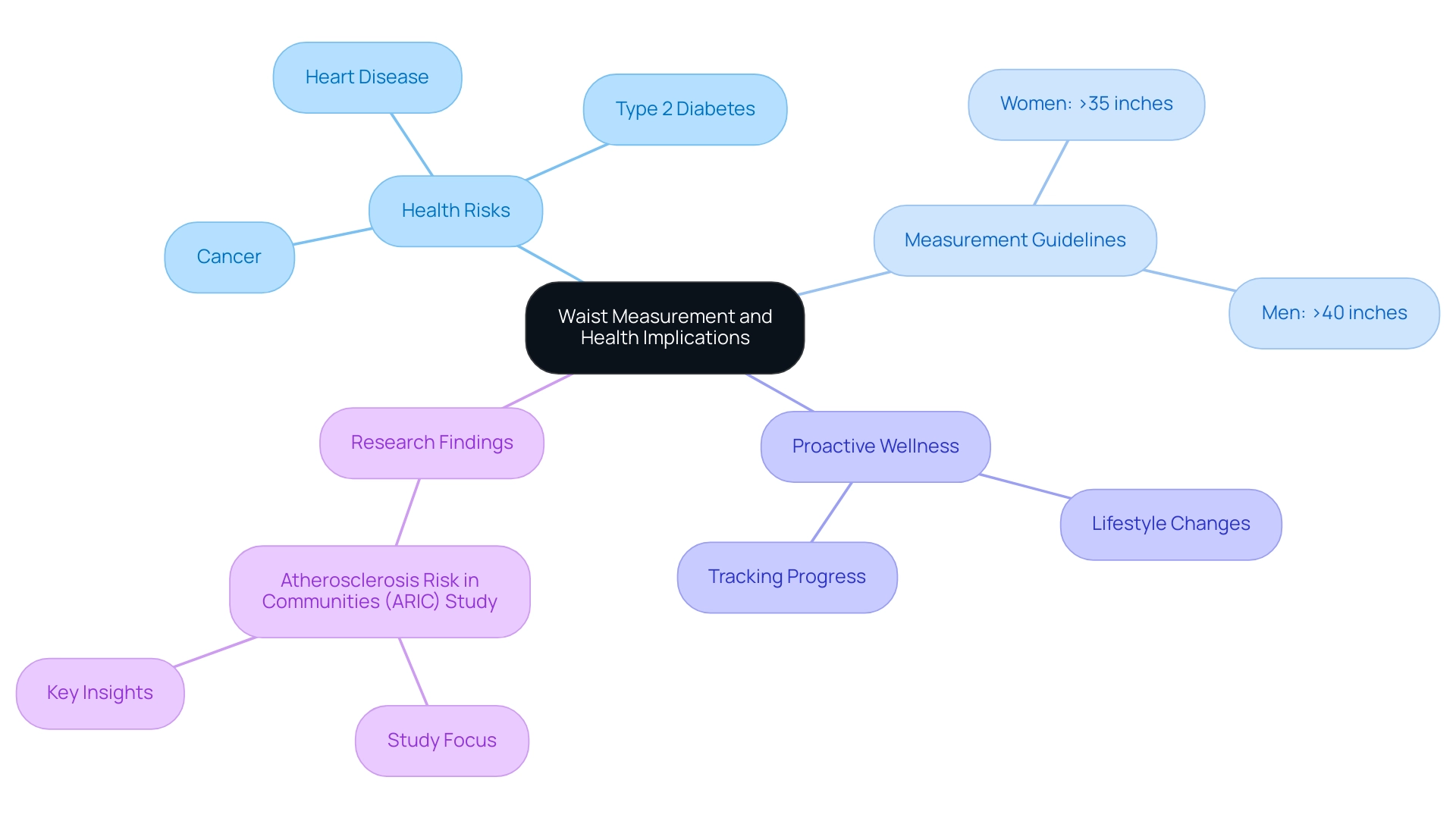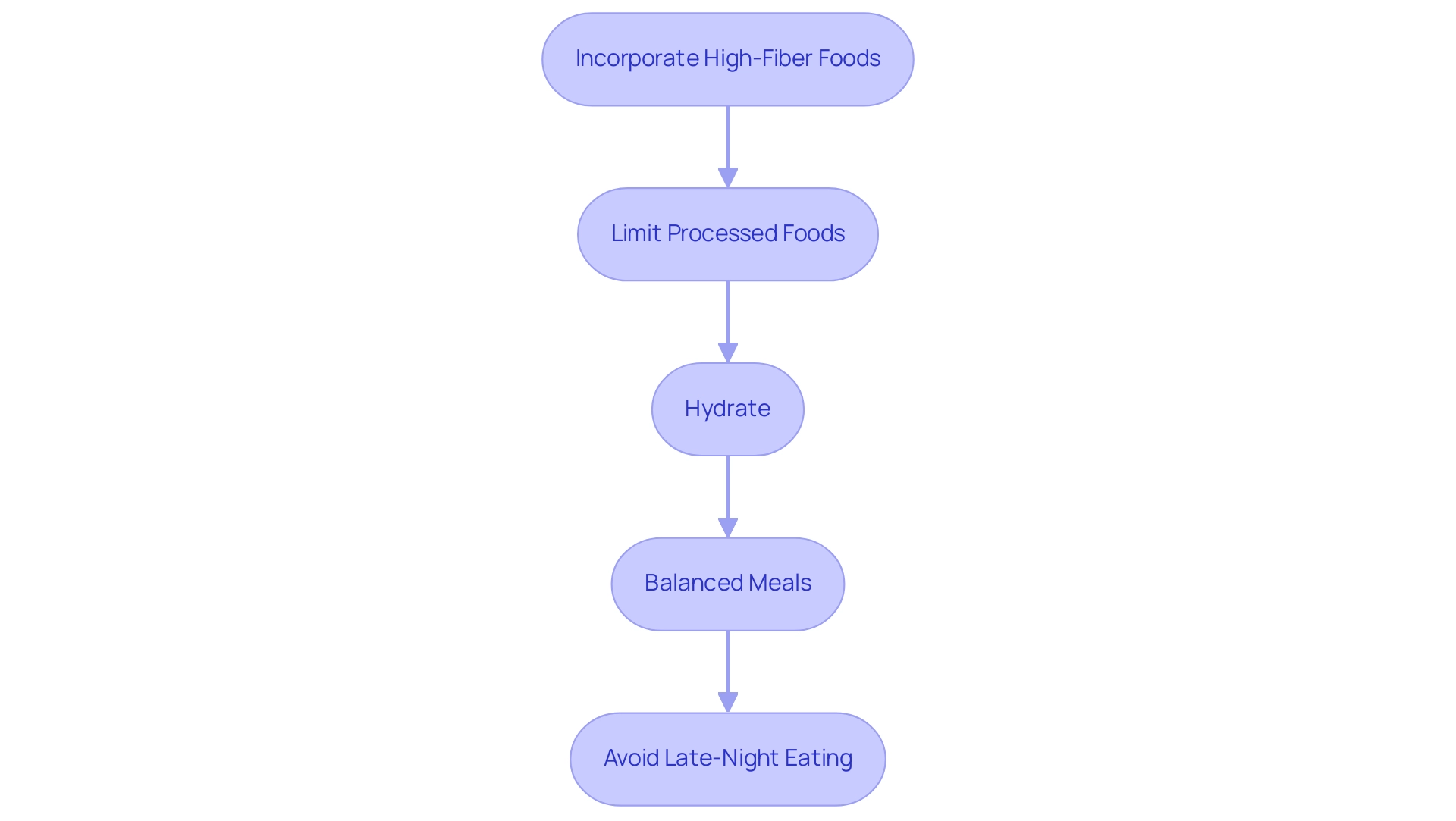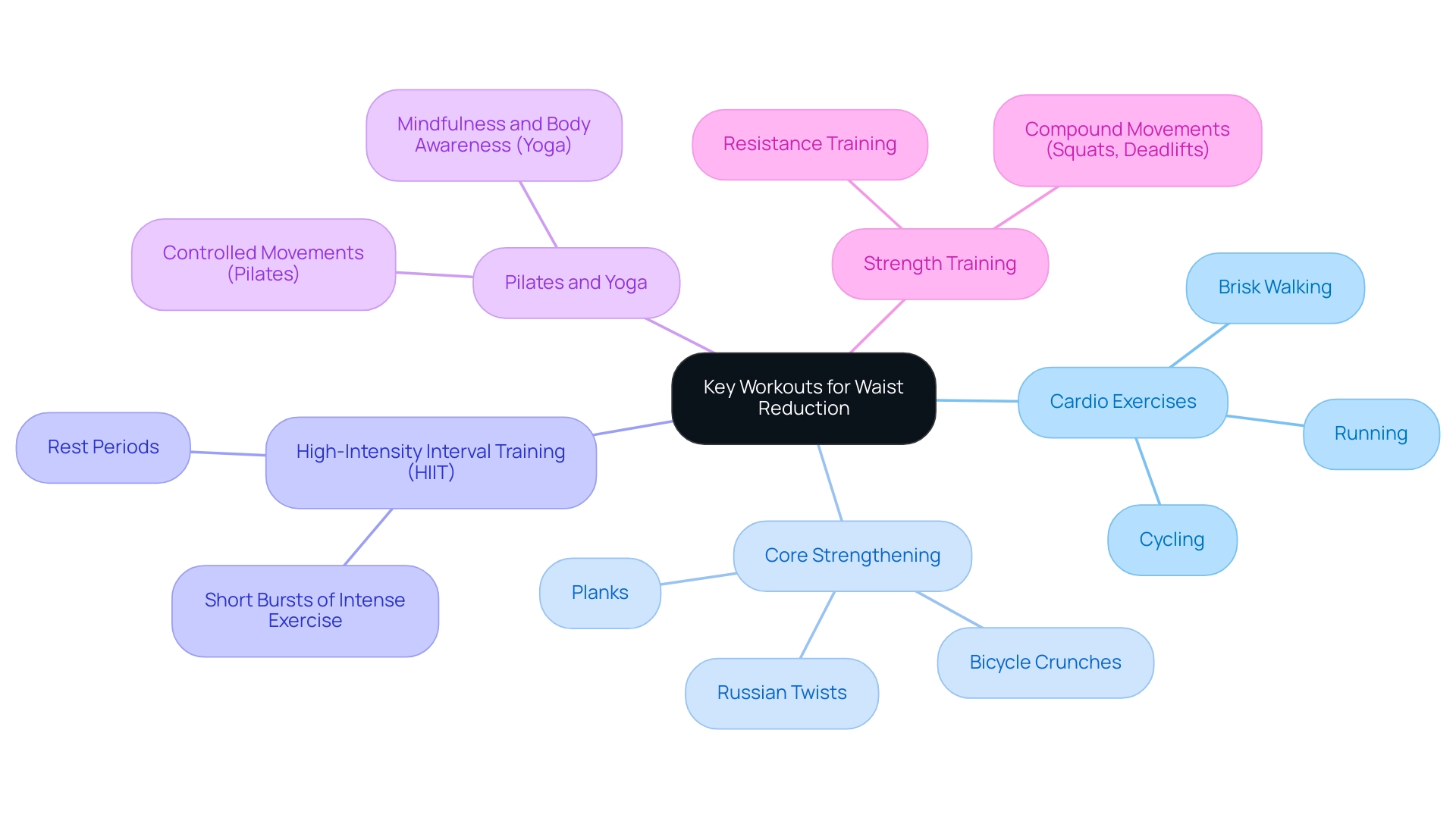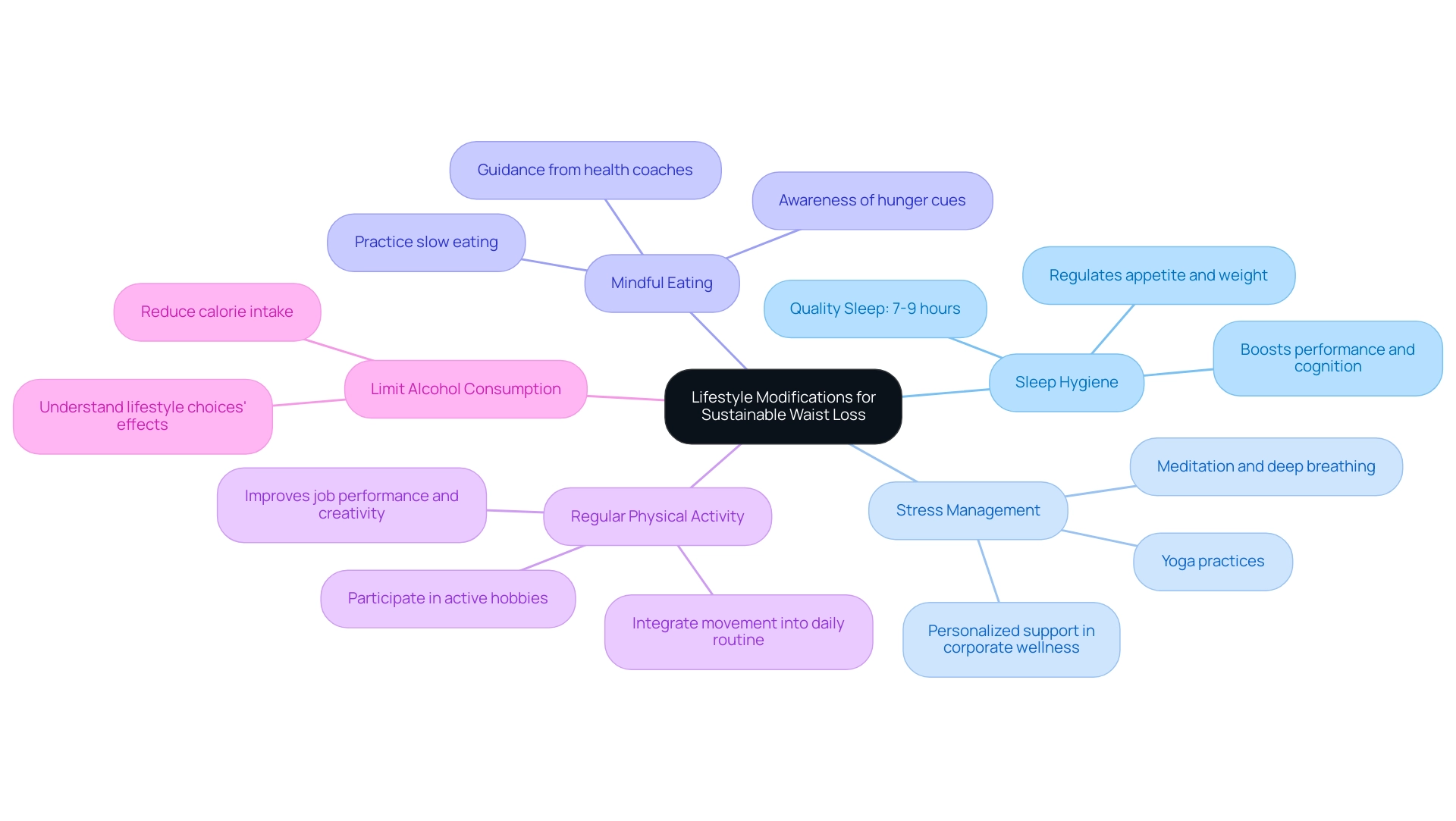Overview
This article serves as a comprehensive guide to losing 2 inches off your waist overnight through dietary changes, exercise, and lifestyle modifications. It draws attention to the effectiveness of strategies such as increasing fiber intake, staying hydrated, and engaging in regular physical activity. These methods not only lead to significant waist reduction but are also supported by research linking them to decreased abdominal circumference and improved overall health. By implementing these changes, individuals can experience a transformative impact on their wellness journey.
Introduction
Waist measurement transcends mere numbers; it stands as a pivotal health indicator, revealing critical insights into an individual's overall well-being. As research increasingly underscores the link between waist circumference and severe health risks—such as heart disease and diabetes—grasping the importance of managing this measurement becomes essential.
With obesity rates on the rise and the associated health challenges becoming more prevalent, individuals are encouraged to take proactive measures toward waist reduction through dietary adjustments, exercise, and lifestyle changes.
This article explores the far-reaching implications of waist measurement, presenting practical strategies for achieving and sustaining a healthier waistline. Ultimately, it aims to cultivate a culture of well-being that benefits both individuals and organizations alike.
Understanding Waist Measurement and Its Health Implications
Waist circumference is a critical indicator of well-being, reflecting the accumulation of visceral fat in the abdominal region. Recent studies have established a clear connection between larger girth measurements and increased risks of serious medical issues, including heart disease and type 2 diabetes. Specifically, a measurement exceeding 35 inches for women and 40 inches for men is associated with a heightened likelihood of developing these conditions.
Understanding your midsection measurement is essential for evaluating overall wellness and can guide necessary lifestyle changes aimed at improving health. Consistently tracking body size not only provides insight into wellness status but also serves as a motivating resource for maintaining a healthier lifestyle.
In 2025, the importance of abdominal circumference is underscored by ongoing research that highlights its role as a modifiable risk factor for various health complications, including cancer prevention. Adhering to international guidelines for torso circumference and physical activity is crucial in mitigating these risks. For instance, the Atherosclerosis Risk in Communities (ARIC) Study, which monitored approximately 16,000 participants over multiple decades, uncovered significant connections between abdominal circumference and cancer incidence, particularly emphasizing the link between waist measurement, body mass index, and cancer outcomes.
This further emphasizes the necessity for awareness and proactive wellness measures.
As the prevalence of obesity continues to rise—impacting 160 million children and adolescents aged 5–19 in 2022—understanding the implications of torso size becomes increasingly critical. The escalating obesity levels highlight the urgency of addressing waist circumference as a medical concern. By focusing on midsection measurement, individuals can learn how to effectively reduce waist size and take informed steps toward enhancing their well-being while lowering the risks associated with excess visceral fat.
Moreover, individuals with consistently low BMI should consult a healthcare professional if they experience unexplained weight loss, as this can also serve as a significant health indicator.

Effective Dietary Changes to Trim Your Waist
To effectively reduce your midsection size, consider implementing the following dietary changes, supported by Foresight Health Coaching's comprehensive wellness services:
-
Incorporating high-fiber foods such as fruits, vegetables, and whole grains is one method for those seeking how to lose 2 inches off waist overnight to significantly aid in weight loss. Research indicates that a high-fiber diet not only promotes satiety but also helps regulate appetite, making it easier to resist cravings. Studies have indicated that individuals who understand how to lose 2 inches off waist overnight by boosting their fiber consumption experience a significant decrease in abdominal circumference. A review of 12 randomized controlled trials (RCTs) involving 609 participants found that a diet rich in fiber may lower the risk of developing conditions like colorectal cancer, highlighting the importance of fiber in a healthy lifestyle.
-
Limit Processed Foods: Reducing the consumption of processed foods is crucial when considering how to lose 2 inches off waist overnight. These foods often contain high levels of sugar and refined carbohydrates, which can hinder your efforts on how to lose 2 inches off waist overnight. By choosing whole, unprocessed foods, you can more effectively manage your body and enhance overall well-being. Foresight's nutritional guidance can help individuals make informed food choices.
-
Hydrate: Staying well-hydrated is essential for maintaining a healthy metabolism and reducing bloating. To understand how to lose 2 inches off waist overnight, drinking sufficient water throughout the day can help flush out excess sodium and prevent water retention, which contributes to a larger waistline. Our wellness coaching app reminds users to track their hydration levels, enhancing their commitment to health goals.
-
Balanced Meals: Strive for balanced meals that include lean proteins, healthy fats, and complex carbohydrates to learn how to lose 2 inches off waist overnight. This combination not only stabilizes energy levels but also provides insights on how to lose 2 inches off waist overnight. A well-rounded diet can enhance metabolic function and promote a healthier body composition. Healthy lifestyle factors, such as these dietary changes, may mediate the benefits of increased dietary fiber intake, ultimately contributing to improved productivity in the workplace.
-
Avoid Late-Night Eating: If you want to know how to lose 2 inches off waist overnight, minimize nighttime snacking and finish your last meal at least 2-3 hours before bedtime to reduce overnight bloating. This practice can help regulate digestion and improve sleep quality, both of which are important for effective weight management. Incorporating these dietary changes can be part of a broader corporate wellness initiative, fostering a culture of well-being within organizations. With Foresight Health Coaching's tailored programs, including in-person wellness talks and comprehensive pantry services, companies can invest in the health of employees, enhancing overall productivity and well-being. Our coaching staff, led by experienced professionals with diverse backgrounds, is dedicated to providing personalized support, ensuring that each employee's wellness journey is effective and sustainable.

Incorporating Exercise: Key Workouts for Waist Reduction
Integrating regular physical activity into your routine is essential for understanding how to lose 2 inches off your waist overnight. Consider these impactful workouts:
- Cardio Exercises: Aim for at least 30 minutes of moderate-intensity cardio, such as brisk walking, running, or cycling, five times a week. This consistent activity not only burns calories but also significantly reduces overall body fat, providing insights on how to lose 2 inches off your waist overnight. Studies indicate that individuals engaging in regular cardio can discover how to lose 2 inches off their waist overnight, resulting in a notable decrease in midsection circumference over time.
- Core Strengthening: Integrate exercises like planks, bicycle crunches, and Russian twists into your routine. These movements specifically target the abdominal muscles, helping to tone the midsection and improve overall core stability. Research shows that understanding how to lose 2 inches off your waist overnight can lead to a more defined waistline and improved posture through core strengthening.
- High-Intensity Interval Training (HIIT): This training method, characterized by short bursts of intense exercise followed by rest, has gained popularity for its effectiveness in fat burning. HIIT remains one of the top 20 global fitness trends, making it a relevant option for those interested in how to lose 2 inches off their waist overnight. HIIT workouts can be tailored to include various exercises, alternating between high-intensity efforts and recovery periods. Fitness specialists highlight that HIIT can be a powerful method for those looking to understand how to lose 2 inches off their waist overnight, resulting in considerable fat loss.
- Pilates and Yoga: Both practices enhance flexibility, core strength, and posture, all of which contribute to a slimmer torso appearance. Pilates focuses on controlled movements that strengthen the core, while yoga promotes mindfulness and body awareness, aiding in stress reduction and overall well-being.
- Strength Training: Incorporate resistance training at least twice a week. Developing muscle not only boosts metabolism but also encourages fat loss, which is essential for understanding how to lose 2 inches off your waist overnight. Engaging in compound movements, such as squats and deadlifts, can further enhance overall body composition.
As the fitness landscape evolves, innovative trends like HYROX indoor fitness racing are emerging, combining strength training, cardio, and running in a competitive format. This trend emphasizes the need for captivating fitness experiences that can effectively aid in reducing size and enhancing general well-being. By embracing a variety of these workouts, individuals can create a well-rounded fitness regimen that supports their goals, including how to lose 2 inches off their waist overnight.
Furthermore, health clubs should consider offering specialized programs for seniors focusing on low-impact exercises and balance training to cater to the diverse needs of employees. The integration of technology, as highlighted by Fitness on Demand, underscores the significance of a data-driven approach to fitness, enabling individuals to develop hyper-personalized fitness plans that aid their reduction efforts.

Lifestyle Modifications for Sustainable Waist Loss
To achieve sustainable waist loss within your organization, consider implementing the following lifestyle modifications as part of a tailored corporate wellness program:
- Sleep Hygiene: Prioritize 7-9 hours of quality sleep each night. Research shows that insufficient sleep can result in increased body mass and intensified cravings, making it crucial for managing body composition. As Abhinav Singh, MD, observes, "Enhancing sleep has demonstrated the ability to boost performance, cognition, and even assist in regulating appetite." Additionally, strong randomized controlled trials are necessary to assess sleep as a part of obesity prevention strategies, emphasizing the vital role of sleep in managing body mass.
- Stress Management: Engage in stress-reducing practices such as meditation, deep breathing, or yoga. Chronic stress can trigger emotional eating, contributing to an increase in mass. Effective stress management techniques not only support mental well-being but also play a crucial role in maintaining a healthy weight. Our corporate wellness programs offer personalized support to help employees manage stress effectively.
- Mindful Eating: Cultivate awareness of hunger cues and practice slow eating to avoid overeating. Mindful eating encourages healthier choices and helps individuals develop a better relationship with food, which is vital for waist management. With experienced health coaches, employees can receive guidance tailored to their unique needs, making lasting lifestyle changes achievable.
- Regular Physical Activity: Integrate more movement into your daily routine, whether through walking, taking the stairs, or participating in active hobbies. Regular exercise has been linked to improved job performance and creativity, further enhancing overall well-being and productivity. Our programs facilitate engagement in regular physical activity, making it easier for employees to stay active.
- Limit Alcohol Consumption: Reducing alcohol intake can significantly decrease calorie consumption, aiding in the maintenance of a healthy waistline. Comprehending the effect of lifestyle choices on body management becomes increasingly important as the obesity market evolves in 2025.
Furthermore, consider the findings from the case study titled "Effects of Obesity on Sleep Quality," which illustrates that obesity is linked to a higher prevalence of insomnia and daytime sleepiness. This relationship highlights the need to tackle both sleep quality and management of body mass simultaneously.
By adopting these modifications within a corporate wellness framework, organizations can create a holistic approach to weight management that addresses both physical and psychological factors, ultimately leading to sustainable weight loss and enhanced employee well-being. Furthermore, investing in corporate wellness programs not only promotes healthier employees but can also lead to lower healthcare costs over time, making it a financially sound decision. Testimonials from clients highlight the effectiveness of these programs, with many reporting significant improvements in employee health and productivity.
Our wellness offerings also include a customized app, ensuring that support is always accessible, further enhancing the commitment to employee well-being.

Quick Tips for Overnight Waist Reduction
To achieve a swift reduction in waist size, consider implementing the following strategies:
- Hydration: Prioritize drinking ample water throughout the day. Staying well-hydrated helps flush out excess sodium, significantly reducing bloating. Studies indicate that proper hydration alleviates bloating symptoms, enhancing overall comfort. This is particularly vital for individuals with IBS, as patients with IBS and fructose malabsorption respond positively to dietary adjustments, including hydration.
- Avoid Heavy Meals Before Bed: Refrain from consuming large meals or high-sodium foods in the evening. Heavy meals can lead to increased water retention overnight, complicating your body reduction goals. As noted by Elizabeth Huebner, MD, FACG, "IBS is one of the most common disorders seen by doctors," and managing dietary intake is crucial for those affected.
- Body Wraps: Explore body wraps infused with natural ingredients such as ginger or coffee. These wraps can temporarily tighten the skin, creating the illusion of a slimmer figure and providing a quick aesthetic boost. However, it’s essential to remember that bloating, the second most common symptom in IBS patients, can affect the effectiveness of such methods.
- Sauna or Steam Bath: Spending time in a sauna or steam bath can effectively sweat out excess water weight. This approach encourages relaxation and can result in a noticeable, albeit temporary, decrease in circumference. Managing symptoms of IBS, such as abdominal pain and bloating, is vital, as they can disrupt daily life and overall well-being.
- Light Exercise: Engage in a brief workout or stretching routine before bedtime. Light physical activity promotes circulation and can help alleviate bloating, contributing to a flatter appearance by morning. Furthermore, psychological elements are associated with the intensity of bloating in IBS patients, suggesting that stress control through exercise may also contribute to managing body dimensions.
By incorporating these tips on how to lose 2 inches off your waist overnight, you can effectively manage waist size and enhance your overall well-being, particularly for those facing the challenges of IBS.

Conclusion
Understanding waist measurement is vital for assessing overall health and mitigating risks associated with obesity-related conditions. The strong correlation between waist circumference and serious health issues such as heart disease and diabetes cannot be overlooked. Proactive measures—including dietary changes, exercise, and lifestyle modifications—are essential for achieving a healthier waistline.
Effective strategies for waist reduction include:
- Increasing fiber intake
- Limiting processed foods
- Staying hydrated
- Engaging in regular physical activity
Furthermore, incorporating mindful eating practices and managing stress through various techniques can lead to sustainable weight loss and improved well-being. Organizations are encouraged to foster a culture of health by implementing corporate wellness programs that support these initiatives.
Ultimately, prioritizing waist measurement as a health metric empowers individuals to make informed choices that enhance their quality of life. By embracing these practical strategies, individuals not only work towards a healthier waistline but also contribute to a broader culture of wellness that benefits both personal and organizational health. Taking action today can lead to significant long-term health benefits, paving the way for a healthier future.




